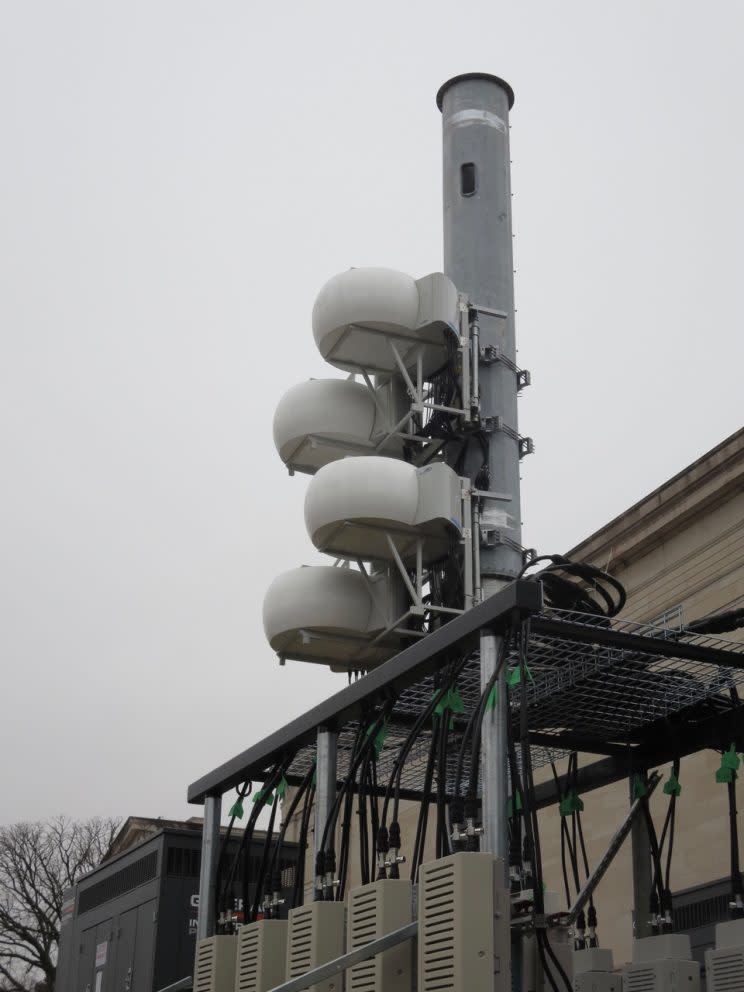How carriers will keep D.C. online during Trump’s inauguration

The Mall in Washington looked a little Dickensian ahead of Donald Trump’s inauguration ceremony. And it wasn’t just the low-hanging clouds and rain. Gray metal columns had sprung up among the national museums and gardens like a series of smokestacks.
No, the Smithsonian Institution isn’t reverting to a coal heating system. Instead, wireless carriers facing what could be more than one million attendees for Friday’s festivities — in addition to a large crowd for Saturday’s National Women’s March protest — are deploying outsized equipment to supercharge their networks and ensure everyone stays online throughout the weekend.
Temporary towers
Wireless carriers have been using mobile cell sites, often called COWs, or cell on wheels, for decades. But the gear set up on the Mall dwarfs the kinds of antenna trucks you’ve probably seen at concerts or other large gatherings.
At a temporary Verizon (VZ) site next to the National Air & Space Museum, the setup resembles an outdoor astronomy exhibit: a large ball on a metal column around 40 feet tall connects to a series of cables running to a diesel generator designed to keep things online if the electrical grid cuts out.
The contraption is a multi-beam base station antenna that can transmit 12 separate cell signals, each of which can be angled up or down remotely. Verizon has seven of them up and down the Mall.
“Let me tell you, they’re expensive,” said Mark Funka, director of system performance at Verizon Wireless. He said Verizon designed its network upgrades for a crowd of from 1 to 1.8 million.
The carrier also says it’s upgraded its capacity across the Washington area by 500%.
At AT&T (T), the most visible addition to its network at the inauguration will be the seven “Super COWs” it has parked along the mall.
The one I inspected next to the National Gallery of Art features four “drum set” multiple-beam antennas, each with 20 times the capacity of a standard single-beam antenna. The antennas are wired to a semi-trailer’s worth of network equipment.
Each antenna sends out 20 beams over multiple frequencies for a more precise distribution of bandwidth, explained Brian Harrison, a technical communications manager. He said AT&T began its inauguration planning two years ago and expects a crowd of 1.2 to 1.8 million. In a statement, the company said it spent $15 million to increase its LTE capacity by 400% in the D.C. area.
T-Mobile (TMUS) and Sprint (S) have also made their own permanent and temporary upgrades. T-Mobile says it has increased LTE capacity on and around the Mall “by nearly 1,000% since last year.”
Sprint, meanwhile, says it has doubled capacity on its 1.9 GHz cell sites around the Mall and nearby Metro stations.
Only-in-Washington issues
Adding coverage for an inauguration differs from augmenting service at other large-scale events like music festivals or the Super Bowl in two important ways.
First, even if Trump’s crowds fall short of the record 1.8 million people who witnessed President Obama’s first inaugural in 2009, they will still vastly outstrip attendance at any music or sports event.
Put another way, the most recent Census estimate put the entire daytime population of Washington at just over one million people. Most sane workers with jobs anywhere near the Mall will take Friday off, but it’s still going to be a bad day to find a seat on Metro.
And as a look at the fences and cameras now set up across the Mall and Pennsylvania Avenue NW will attest, security is much stricter. Verizon’s Funka said that starting at 1 a.m. on Friday, the Secret Service will begin inspecting the company’s installations, opening every cabinet before sealing them all and shutting everything behind fences.

Can the carriers provide sufficient bandwidth for what Funka said will be ”the most connected inauguration in history”? Industry analyst Roger Entner, founder of Recon Analytics, doesn’t think so.
“What can they can do is, they can increase the coverage and the capacity of the area,” he said. “But a million and a half people, and everybody wants to livestream the president taking his oath, that will crush any network.”
Then — I swear I’m not making this up — the call dropped.
What you should do
If you’re going to the inauguration to cheer, protest or simply witness the peaceful transfer of power, you should prepare as if you’re going to a major conference like CES, but with crummy weather and even fewer power outlets. Bring a backup battery for your phone and stick with text messages whenever possible — they use less bandwidth than anything else on your phone.
But don’t waste your time disabling WiFi or Bluetooth; the former will let your phone locate you using less energy than GPS, while the latter should have zero effect on battery life.
If you want to stream the proceedings with Facebook Live or Twitter’s Periscope, give it a try — but prepare for disappointment and the real possibility that you’ll jam up everybody else’s bandwidth. After calling me back, Entner warned that live video streaming is “what kills it for everybody.”
Finally, before you leave your house or hotel, open the Google Maps app and download a map of Washington for offline use. But if you’re not from around here, and your phone’s battery life isn’t the greatest, you may be better off reverting to a technology in wide use at President Clinton’s first inauguration in 1993: a paper map.
Disclosure: Verizon is in the process of buying Yahoo Finance’s parent company, Yahoo.
More from Rob:
Email Rob at [email protected]; follow him on Twitter at @robpegoraro.
